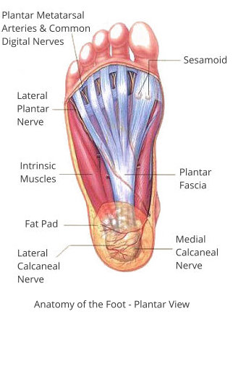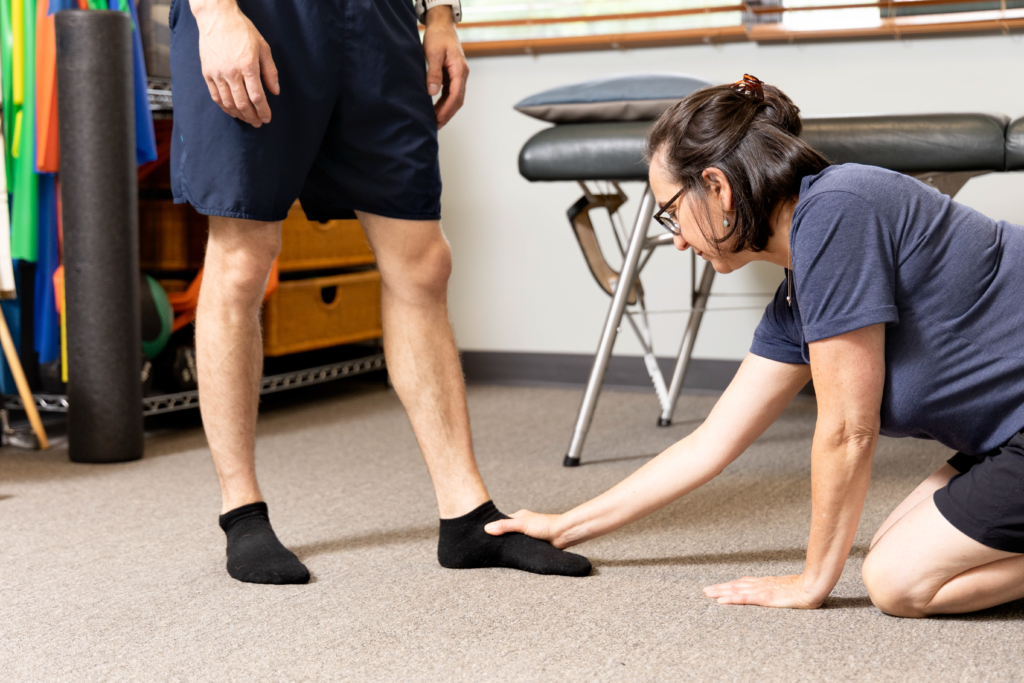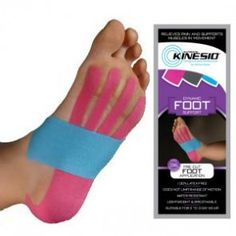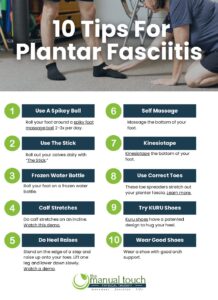When you get out of bed in the morning and take your first few steps, do your feet feel like blocks of painful cement? Does the bottom of your foot, heel, or arch hurt with every step? Do you ever have pain on the sides of your heel, but as you walk your foot feels better? If this sounds like you, it’s possible you have a condition called plantar fasciitis.
What causes plantar fasciitis?
Holly plays pickle ball and participates in high-intensity aerobic classes. Stacy is a runner. Lynn is a graphic designer who spends a lot of time sitting at a desk, and walks her dog a couple of times per day. They all came to me with plantar fascitis, an annoying condition that can affect anyone, whether you’re fairly sedentary or spend a lot of time on your feet standing, running, walking, or playing tennis. It doesn’t matter if you have flat feet or high arched feet. However, one of the issues people with plantar fascitis always have in common is very tight calves and achilles tendons.
What is plantar fasciitis?

The plantar fascia is a thick band of tissue that runs on the bottom of your foot from your toes to your heel. When overused, the plantar fascia develops microtears and inflammation. As your body attempts to heal the microtears, the fibers of the plantar fascia become disorganized creating scar tissue-like tightness. It’s very painful. At this point, there is no longer inflammation and your condition becomes chronic.
How to heal from plantar fasciitis
The key to overcoming plantar fasciitis is to get a handle on the issue as soon as possible before it becomes chronic. It can take a really long time to get better on its own and, even with treatment, can still take upwards of six months or more to be completely pain-free.
The good news is there are many things you can do immediately to decrease pain and tightness from plantar fasciitis and promote healing:
- Roll your foot around this spiky Foot massage ball 2-3x/day
- Roll out your calves daily with The Stick
- Roll your foot on a frozen water bottle
- Calf stretches on an incline. To do this, lean against a wall with you back foot on an incline (you can use a rolled up yoga mat or a towel). Bend your front leg and then, rock your hips forward and backward six times. Next, move your hips side to side so you feel movement down into ankle, six times. Lastly, swivel your hips right and left so you feel movement down into ankle. Need help? Watch this short demonstration.
- Heel raises with eccentric loading of the plantar fascia and achilles tendon. Recent studies show that eccentric loading (using your muscle in a lengthened position) of the plantar fascia/achilles tendon promotes faster healing. Here how to do it: Stand on the edge of a step and raise up onto your toes. Lift one leg and lower down (eccentric) slowly on one leg. Repeat raising up on two feet and lowering on one foot. Do this ten times on each leg in three different positions: feet straight ahead, legs/feet turned in, legs/feet turned out. For help, watch this short demonstration.
- Self massage. Massage the bottom of your foot while flexing your toes/ankle up and down. Using a massage tool can be helpful to prevent strain of your hands/fingers.
- Kinesiotape the bottom of your foot.
- Correct toes. These toe spreaders stretch out your plantar fascia so your whole foot is on the ground improving balance and foot alignment. Start by wearing Correct Toes two hours per day with a pair of socks and wide shoes such as crocs.
- KURU shoes. Many of my patients really like KURU shoes. They have a patented design to hug your heel. In fact, the week before leaving for a two-week trip to Israel, my aunt developed plantar fasciitis, so we had to think fast. I suggested she go to the podiatrist who gave her a pair of over-the-counter orthotics. I then provided soft tissue massage to the bottom of her foot and recommended KURU shoes. And,success! She was able to enjoy her Israel trip without significant pain.
- Wear appropriate shoes all the time. Wear a shoe with good arch support. This could be a walking or gym shoe or even a good sandal or flip flop such as fit flops.
- Medical treatment. Steroid shot, oral steroids, shockwave, or custom orthotics are some common medical treatments.
In addition to the above, I highly recommend coming in to physical therapy. Why? Your physical therapist will evaluate you to determine why you got plantar fasciitisin the first place. Then, they’ll show you specific exercises for your individual needs that will help promote better movement, strength, balance, and coordination. You’ll also receive hands-on therapy to your feet, legs, and back. Activity modifications and shoe and orthotic recommendations will also be provided to promote pain relief and recovery.
If the above recommendations do not help or make you worse be sure to see your podiatrist or doctor to determine the exact cause of your foot pain as it could be something other than plantar fasciitis.









What a treasure trove of excellent advice. The links to the tools for dealing with this condition were very helpful . I appreciated the video demonstrating the correct way to do the stair-based exercise . I am sure that I would not have been able to do it correctly without that visual guide. this was a wonderfully informative newsletter. Than you!